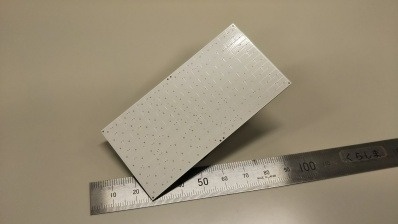Mini LED 8x16 board production part 1
I am “R” from the Sales Technology Group.
It seems that the main uses of miniLED are backlights and displays.
The backlight has become particularly famous for being adopted in the iPad Pro. We also had a demo machine that imagined a light source for such a backlight, but it was damaged by the activity for many years (?).
Therefore, we decided to make a demo machine with the image of a new backlight source.
The main goals are:
- The LEDs are arranged in a matrix and can be freely controlled to some extent.
- Being able to handle later when we want to raise a board with a different pitch.
- The distance between the LED and the edge of the board should be half pitch on all four sides so that tiling can be performed.
- As cheap as possible (important!) and hard to break.
After investigating various things, it was decided that it would be better to use an IC called HT16K33 that can control 8x16 LEDs.
The point we were worried about was that although the Dimming function can be used to control the brightness as a whole, it is not possible to display halftones and the current that flows seems to be a little large. The merit is that it seems to be easy to handle and that many dedicated boards are sold by Akizuki Denshi. Moreover, it costs 250 yen per sheet.
Since the halftone display is not possible because it is a demo machine, we decided to select a current that can pass a certain amount of current. It is a pity that the smallest size (0.1mm x 0.2mm) that we have a track record of handling cannot be used.
And here is the completed board.

8x16 mini LED board
The LEDs have a pitch of 5 mm, and 128 LEDs in 8 rows and 16 columns can be placed on a single board.
Since the distance to the LEDs on the four sides is 2.5 mm, we should be able to display tiling by arranging these boards side by side. The control program seems to be difficult.
The board is a general FR-4 board. To make it easier to handle as a demo machine, we use a thick board of 1.2 mm.
The point that this board was devised is:
- The HT16K33 board sold by Akizuki Denshi was soldered so that it could be used.
- Since it is necessary to create a cradle if parts are bonded on the back of the board when bonding the mini LED, the LED driver is bonded after bonding the LED. With this structure, it is possible to handle substrates with different pitches.
- It was made easier to assemble by making it possible to connect the power supply / signal line to the adjacent board during tiling.
- The wiring can be pulled out as an LED matrix of 16-pin anode x 8-pin cathode so that it can be controlled by other ICs.
and so on.
Next time, we would like to bond the LED on this board and turn it on.
